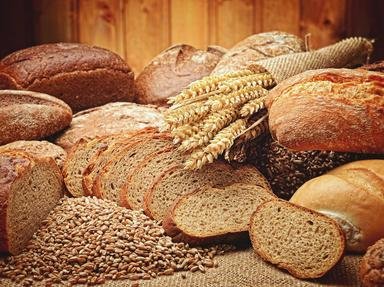Quiz Answer Key and Fun Facts
1. Kev the Chef, just a little nervous addressing a class of apprentices, adjusts his white apron. "Use your noodles, class. What sort of whole grain, often used in pancakes, would generally be used to make Japanese soba noodles?"
2. Kev the Chef places a bowl of coarse grain on the table. "This is bulgar wheat, which can be used as a tasty whole-grain substitute for rice in a dish such as pilaf," he states. "Does anyone have a ghost of an idea of what traditional Middle Eastern dish is usually made using bulgar?"
3. Kev the Chef's voice takes on a reminiscent tone as he talks about the next whole grain. "My dear old Mum used to make the best veggie soup and included this grain for both texture and nutrition. It lowers cholesterol too! But I bet you've had this grain more often in a schooner of beer! True or false, class? Is this grain barley?
4. "I've eaten rolled oats made into creamy porridge every morning for the last fifteen years!" boasts Kev the Chef. "It's a tradition at my place to put milk and brown sugar on it, but the doc tells me that's not such a great idea. One little known fact about oats, though - can you lads and lassies tell me in which country universities used to grant students a day off study to go home to their farms and help gather more oats for food?"
5. Kev the Chef shows the class a wonderful-looking salad. "This is quinoa, the whole grain superfood of which I'm sure most of you have heard - you may even have eaten it. Though it's not a true cereal, as it's not a grass, it does contain extremely high levels of protein, with 18 grams per cup of cooked grain. Its botanical name is Chenopodium, but can any of you birdbrains tell me its common name?"
6. "Time to wet your whistles, class," says Kev the Chef. "Are you able to tell me what toasted whole grain is combined with green tea leaves to make the Japanese drink, genmaicha?"
7. Kev the Chef displays a soft, pliable flatbread to the class of apprentices. "This is injera, and it's made from a whole grain called teff. It's served under a traditional dish, tsebhi, a kind of curry made from lamb or chicken which you may also have heard called 'wat'." Kev chuckles; I know a pun is coming. "In WAT African country are these traditional foods?"
8. "Who'd like to take a guess about this next whole grain, which is called freekeh?" asks Kev the Chef. "You probably already know, being studious apprentices, that it's an ancient grain traditionally cooked with spices such as coriander and cinnamon, and served with cooked lamb. But can you tell me what's different about freekeh when compared with ordinary wheat?"
9. Kev the Chef chuckles to himself as he introduces the next whole grain to the class. "Now, I know you've all eaten this little gem," he says. "There's dozens of ways to eat it, and it's been used for thousands of years in cooking across the world, and for feeding to animals, as well. My favourite way to eat it is out of a box or bag at the movies. Okay, I admit to adding a little butter to it," says Kev, patting his tummy. "Which of you clever-looking apprentices is bursting to tell me what this grain is?"
10. "Now look at this little beauty," says Kev the Chef, running a small yellowy grain through his fingers. "You've all heard of millet before, I'm sure and this variety, pearl millet, is great for making creamy porridge to which you can add fruit or nuts, and it's great to add a handful to the batter when you're making muffins or pancakes. Sadly, millet is more often seen as a food for what creature, rather than as food for people?"
Source: Author
VegemiteKid
This quiz was reviewed by FunTrivia editor
WesleyCrusher before going online.
Any errors found in FunTrivia content are routinely corrected through our feedback system.

